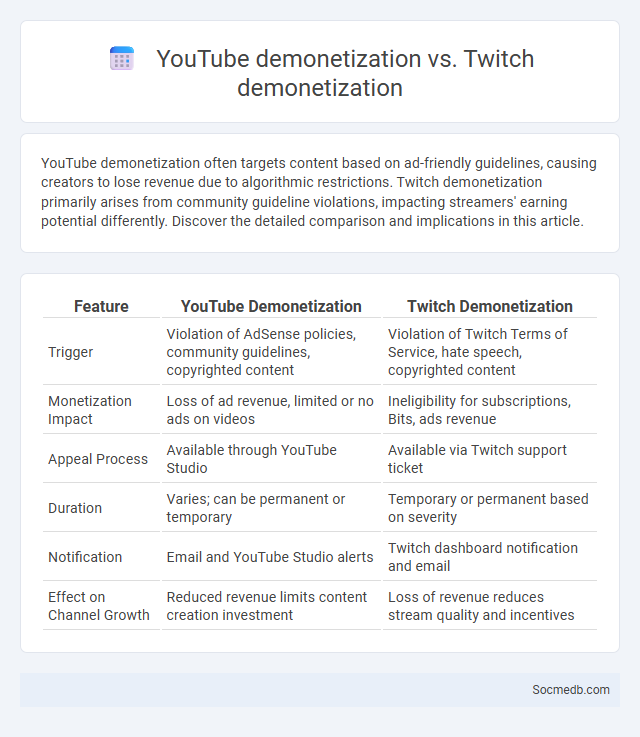
Photo illustration: YouTube demonetization vs Twitch demonetization
YouTube demonetization often targets content based on ad-friendly guidelines, causing creators to lose revenue due to algorithmic restrictions. Twitch demonetization primarily arises from community guideline violations, impacting streamers' earning potential differently. Discover the detailed comparison and implications in this article.
Table of Comparison
| Feature | YouTube Demonetization | Twitch Demonetization |
|---|---|---|
| Trigger | Violation of AdSense policies, community guidelines, copyrighted content | Violation of Twitch Terms of Service, hate speech, copyrighted content |
| Monetization Impact | Loss of ad revenue, limited or no ads on videos | Ineligibility for subscriptions, Bits, ads revenue |
| Appeal Process | Available through YouTube Studio | Available via Twitch support ticket |
| Duration | Varies; can be permanent or temporary | Temporary or permanent based on severity |
| Notification | Email and YouTube Studio alerts | Twitch dashboard notification and email |
| Effect on Channel Growth | Reduced revenue limits content creation investment | Loss of revenue reduces stream quality and incentives |
Understanding Demonetization: Definition and Impact
Understanding demonetization on social media involves recognizing how platforms restrict or remove monetization privileges from your content, affecting revenue streams like ads and sponsorships. This process often targets violations of community guidelines or copyright infringements, drastically reducing your earnings potential. Grasping the specific reasons and impacts of demonetization helps you adapt strategies to maintain compliance and safeguard your income.
What is YouTube Demonetization?
YouTube demonetization refers to the process where YouTube removes or restricts ads on your videos, limiting your ability to earn revenue through the YouTube Partner Program. This often occurs when videos violate community guidelines, contain copyrighted content, or are deemed unsuitable for advertisers. Understanding YouTube's content policies and maintaining compliance can help protect your channel's monetization status.
How Twitch Demonetization Works
Twitch demonetization occurs when content violates platform policies, leading to restrictions on earning revenue through ads, subscriptions, and bits. Automated systems paired with user reports identify content that breaches community guidelines or copyright rules, triggering demonetization. Streamers can appeal decisions, but repeated violations may result in extended revenue loss or channel suspension.
Key Differences Between YouTube and Twitch Demonetization
YouTube demonetization primarily relies on algorithmic reviews that assess content for advertiser-friendliness, including factors like language, violence, and adult themes, often leading to partial or full ad revenue restrictions. Twitch demonetization focuses more on community guidelines violations and content appropriateness during live streams, with stricter rules on language and real-time moderation impacting your earning potential. The key difference lies in YouTube's reliance on automated content analysis versus Twitch's emphasis on live behavior and community enforcement.
Common Reasons for Channel Demonetization
Common reasons for social media channel demonetization include repeated violations of platform policies such as spreading misinformation, posting copyrighted content without authorization, and sharing inappropriate or harmful material. Channels that fail to comply with community guidelines on hate speech, harassment, or graphic content risk losing monetization privileges. Platforms often demonetize channels exhibiting artificial engagement patterns like fake followers or likes, which compromise content authenticity and advertiser trust.
YouTube Demonetization Policies and Guidelines
YouTube demonetization policies enforce strict adherence to content guidelines, including restrictions on hate speech, violent content, and copyright infringement, to maintain advertiser-friendly videos. Understanding these policies helps You protect your channel from losing monetization and ensures your videos meet YouTube's community standards and advertiser requirements. Staying updated on YouTube's changing guidelines is essential for maximizing revenue and maintaining a successful content creation strategy.
Twitch Partner Program and Revenue Restrictions
The Twitch Partner Program offers content creators monetization opportunities through subscriptions, ads, and Bits, enabling consistent revenue streams for eligible streamers who meet specific criteria such as follower count and average viewership. Revenue restrictions on Twitch include geographical limitations on payout availability and compliance with platform policies, which can impact payment methods and frequency. Streamers must adhere to Twitch's Terms of Service and community guidelines to maintain partnership status and uninterrupted access to monetization features.
The Broader Scope of Demonetization Across Platforms
Demonetization across social media platforms has escalated, impacting content creators' revenue streams on YouTube, Facebook, and TikTok through stricter ad policies and algorithm changes. Brands and influencers face increased challenges adapting to fluctuating monetization rules, affecting engagement and income sustainability. Understanding these shifts helps you navigate platform dynamics and optimize your content strategy to maintain financial stability.
Strategies to Avoid Demonetization on Both Platforms
To prevent demonetization on social media platforms like YouTube and Facebook, you should strictly adhere to each platform's community guidelines and copyright policies. Consistently creating original, advertiser-friendly content and avoiding controversial or sensitive topics reduces the risk of demonetization. Monitoring your analytics for sudden drops in revenue helps you adjust your strategies proactively and maintain your monetization status.
The Future of Demonetization: Trends and Predictions
The future of demonetization on social media platforms is expected to shift toward more sophisticated AI-driven content moderation and personalized monetization strategies. Emerging trends indicate a rise in microtransactions and creator-centric revenue models, fueled by blockchain technology and NFTs. Predictive analytics will enable platforms to optimize ad placements and curb misinformation, reshaping the digital economy landscape.
 socmedb.com
socmedb.com